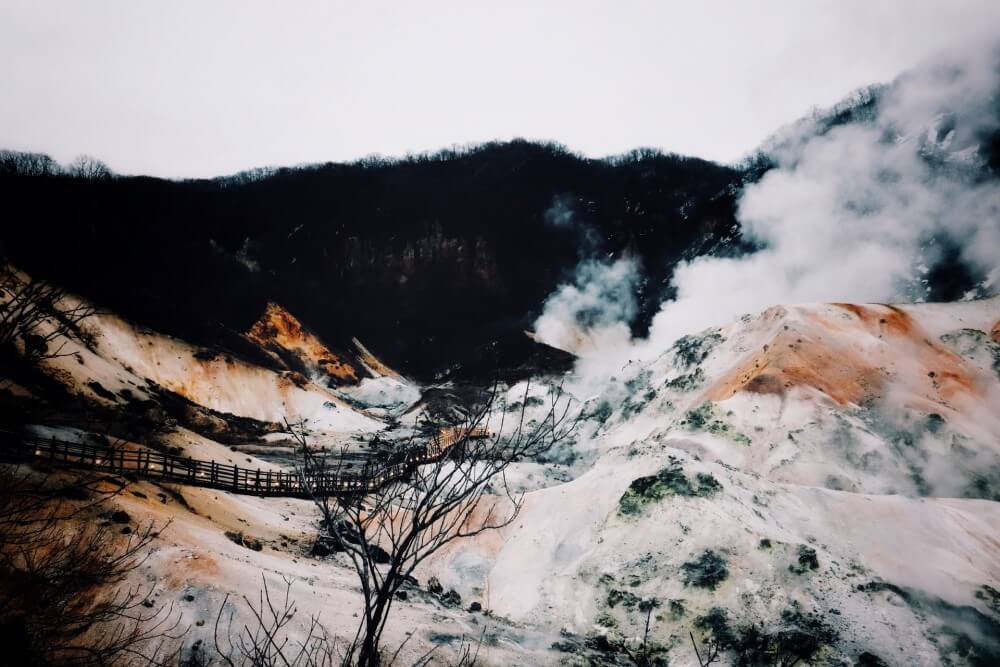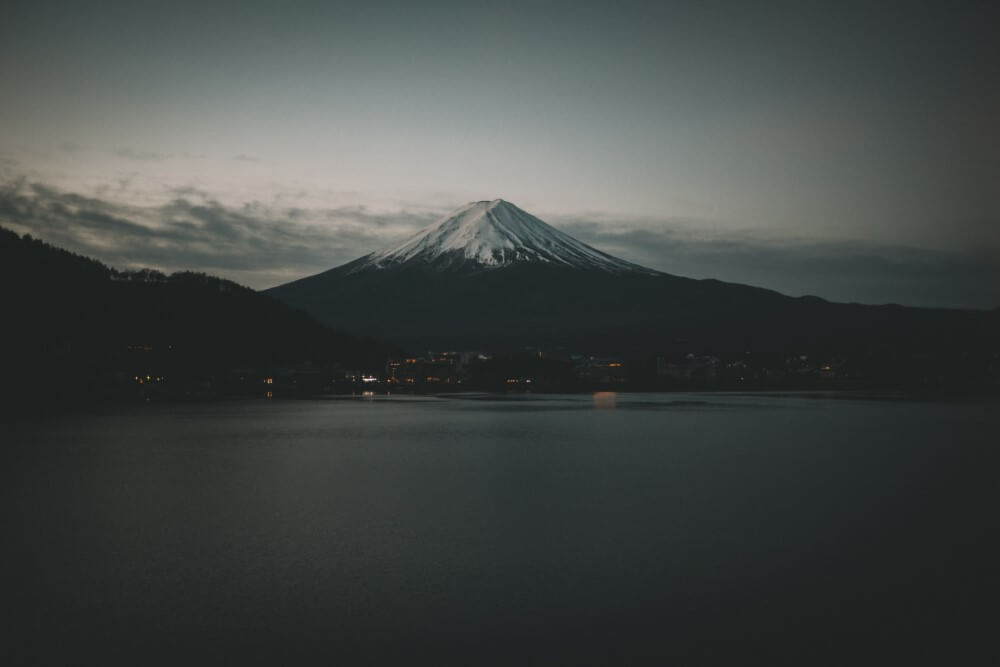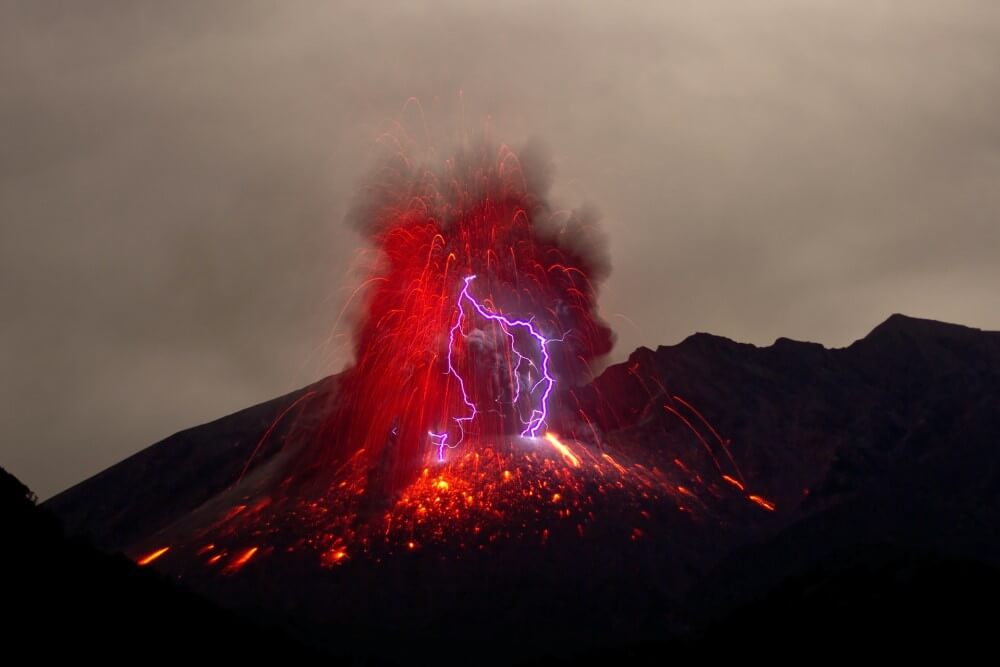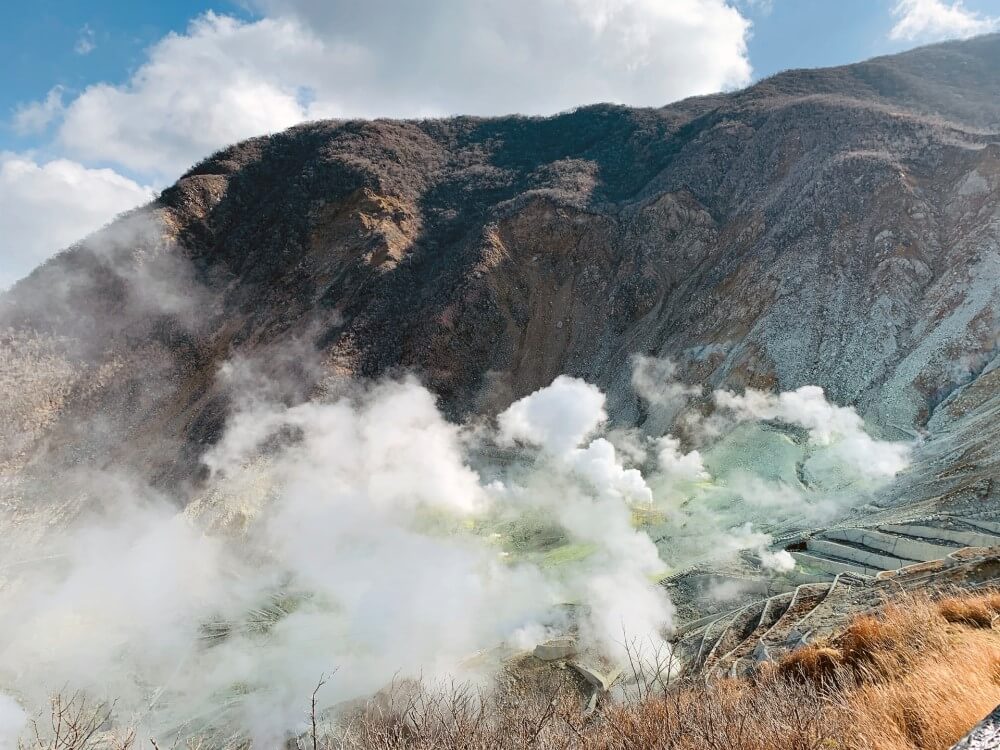- Japan Tips
25 Amazing Volcanos In Japan
Whilst Japan may appear small in size, the country is home to a staggering number of incredible volcanoes. In fact, 10% of the world’s active volcanoes belong to Japan!
With volcanic activity that spans throughout the country, there are plenty of opportunities to see incredible mountain peaks, hot springs, and breathtaking views.
Whether you’re looking for a challenging hike – or simply want to observe these wonders from a distance – our team have put together this list of 25 amazing volcanoes in Japan for you to reference:
Volcanoes of Hokkaido
Sitting in the northernmost region of Japan, and renowned for fresh seafood and geothermal springs, Hokkaido features some of the country’s most incredible volcanoes:
Daisetsuzan Volcanic Group
Status: Active
The Daisetsuzan Volcanic Group contains 20 volcanoes; the tallest – and most famous of which – is Mount Asahi. The group consists primarily of stratovolcanos and lava domes, though the last recorded eruption was in 1739.
The area is a popular tourist destination, with people coming to see the impressive scenery and enjoy the hiking trails that wind through the volcanoes.
Mount E-san
Status: Active
Mount E-san is a stratovolcano located in the south of Hokkaido. Although being an active volcano – with the last recorded eruption being in 1874 – it serves as an immensely popular tourist destination.
Visitors can use the promenade to walk up to the top of the volcano, which takes approximately an hour and is 618 metres above sea level.
The views from the top of Mount E-san are breathtaking, with panoramic views of the surrounding countryside and mountains. There are also various other tourist attractions nearby, including E-san Prefectural Natural Park and the Mizunashikaihin Hot Spring.
Mount Iō
Status: Active
Mount Iō is an andesitic stratovolcano that’s erupted seven times in recorded history. The first eruption was recorded in approximately 850 AD, while the most recent eruption was recorded in 1936.
The volcano is known for erupting liquid sulphur, particularly in the most recent eruption in 1936. It’s a particularly popular destination for climbing and hiking, attracting tourists from all over the world.
The volcano has an elevation of 1,562 metres, with fantastic views from the summit.
Mount Rausu
Status: Active
Mount Rausu is a stratovolcano located in the Shiretoko Peninsula on the northeastern coast of Hokkaidō.
The volcano is believed to have erupted three times over the last 2,200 years, with the most recent eruption being around 1800.
Mount Rausu is known for being one of the most well-known volcanoes in all of Japan, being particularly popular amongst climbers. The volcano holds an opening festival each year on the 3rd of July, which kicks off the climbing season.

Volcanoes of Honshū
Taking the title of Japan’s largest and most populated island, Honshu is still packed with volcanic activity.
Whilst not only featuring the country’s most famous volcano – Mount Fuji – an array of ranges still remain active.
Mount Adatara
Status: Active
Mount Adatara is a stratovolcano located in Fukushima. It has erupted numerous times, most notably in 1900 and 1996.
In particular, the 1900 eruption killed 72 people working in a nearby sulphur mine, making this one of the most notable and devastating volcanic eruptions in Japan’s history.
The 1,728-metre summit can be reached by hiking or climbing, while there is also a gondola that takes visitors to a viewpoint at approximately 1,300 metres.
The volcano is also particularly well-known for its selection of flowers and hot springs, making it excellent for sightseeing.
Mount Akita-Komagatake
Status: Active
Mount Akita-Komagatake is a stratovolcano located near the border of Iwate and Akita. It serves as the tallest mountain within the Akita Prefecture, while also serving as a popular destination for hikers given its large abundance of trails.
The volcano is active, with the last recorded eruption being in 1971. It’s known amongst locals and tourists alike for its rewarding mountain and views, as well as the view of Lake Tazawa, which is situated to the side of the volcano.

Mount Fuji
Status: Active
Mount Fuji is a stratovolcano that serves as the highest mountain in Japan, standing at 3,776 meters.
Mount Fuji has been active for about 25,000 years and last erupted in 1707. The mountain is surrounded by five lakes: Lake Kawaguchiko, Lake Saiko, Lake Yamanakako, Lake Shojiko, and Lake Motosuko.
Mount Fuji has been seen as a sacred mountain since ancient times, with many locals and tourists climbing the mountain for worship purposes.
The volcano has also been a core subject of Japanese art since around 1600, featuring in famous works such as Katsushika Hokusai’s Thirty-Six Views of Mount Fuji.
Mount Haku
Status: Active
Mount Haku – also known as Mount Asama – is a volcano located on the border of Nagano and Gunma prefectures in Japan. It’s known for its spiritual qualities and serves as one of Japan’s Three Holy Mountains (the others being Mount Fuji and Mount Tate).
Mount Haku stands at 2,702 metres, making it one of the tallest volcanoes in all of Japan. It’s thought to have first been active up to 400,000 years ago, though its last recorded eruption was in 1659.
Mount Haku is also famed for its geological features, particularly outcroppings from the Mesozoic era’s Jurrasic period. Plant life also thrives on the volcano, particularly alpine plants such as the chocolate lily.

Izu Islands
Decorated with tropical white sandy beaches and energetic forests, this island not only offers incredible wildlife, but also rugged volcano-crafted landscapes.
Don’t miss out on the volcanic wonders of the Seven Islands:
Mikura-jima
Status: Active
Mikura-jima is a volcanic island located around 120 miles south of Tokyo. While less than 400 residents live on the island of Mikura-jima, it’s visited by over 10,000 people each year.
It’s considered active, though the last eruption took place approximately 6,000 years ago.
Mikura-jima boasts rich forestry as well as active bird life, including warblers, thrushes and wood pigeons. Dolphin watching is also a popular activity on the island, with dolphin watching tours and excursions taking place over the summer months.
Izu-Ōshima
Status: Active
Izu-Ōshima is a volcanic island located approximately 14 miles east of the Izu Peninsula. It’s considered one of the most active volcanoes in the world, with a history of erupting every couple of years between 1910 and 1990.
The most significant eruptions occurred in 1965 and 1986, forcing the island’s residents to evacuate. However, the volcano has not erupted since.
Much like Mikura-jima, Izu-Ōshima is known for its abundance of bird life, including warblers and thrushes. As such, it serves as a popular tourist destination, with ferry services running regularly from Takeshiba Sanbashi Pier.
Nii-jima
Status: Active
Nii-jima is a volcanic island located approximately 100 miles south of Tokyo. It consists of eight rhyolitic lava domes, with the last recorded eruption occurring in the 9th century.
The area surrounding Nii-jima is particularly susceptible to earthquakes, averaging between 10 and 20 magnitude 5 earthquakes per year. Despite this, it remains a popular tourist attraction, particularly for windsurfers.
The island is known for its beaches and hot springs, boasting white sand and active bird life. There’s also a Shinto shrine in the north-west of the island, which is particularly popular amongst worshippers.
Sumisujima
Status: Active
Sumisujima is a small volcanic island located around 70 miles from the coast of Aogashima. The island has recorded several submarine eruptions over the years, though the last recorded eruption was in 1916.
The island is largely submerged in the sea, with the only visible portion standing at 134 metres tall and having a diameter of approximately 6 miles.
Sumisujima is estimated to have been created by a volcanic eruption approximately 20,000 years ago, though the volcano has been significantly eroded over the ensuing years.
Ogasawara Archipelago
Offering a variety of landscapes and being home to plenty of endangered wildlife, the Ogasawara Archipelago is constructed of over 30 tropical and subtropical islands.
This set of islands is a natural wonder, bursting with some volcanic wonders:
Nishinoshima
Status: Active
Nishinoshima is a volcanic island located almost 600 miles south-east of Tokyo. The island has seen significant volcanic activity over the last five decades, with eruptions occurring in 1973-74, 2013-2015, 2017, 2018, 2019-2020 and 2021.
Nishinoshima’s eruptions have led to substantial morphology, including the development of additional cylinder cones in 1974 and significant expansion of the island in 2015.
The island and its surroundings are well-known for an abundance of wildlife, including dolphins, birds, and short-finned pilot whales. Given its highly active status, it does not serve as a popular tourist attraction.
Fukutoku-Okanoba
Status: Active
Fukutoku-Okanoba is a small, submarine volcano located in the Bonin Islands of Japan. The volcano has experienced several eruptions over the course of recent history, with notable eruptions occurring in 1986, 2010, and 2021.
The island is very small compared to many of the others on this list, standing at just 29 metres in height and approximately half a mile in diameter. Given its small size – as well as its recent history of volcanic activity – it is rarely visited by tourists or local residents.
Suiyo Seamount
Status: Dormant
Suiyo Seamount is a submarine volcano based just south of Torishima. It belongs to a group of submarine volcanoes known as the Shichiyo Seamounts, which are each named after the different days of the week. Suiyo translates to Wednesday in Japanese.
The volcano is known for its hydrothermal activity, which was most notably observed in 1991. In July of this year, hydrothermal activity raised water temperatures to 290°C.
Iwo Jima
Status: Active
Iwo Jima is situated in the south of the Bonin Islands and has an extensive history of eruptions. The first recorded eruption took place in approximately 760BC, with 15 instances of eruptions or volcanic earthquakes taking place over the ensuing years.
In particular, the volcano has experienced 9 eruptions over the course of the 21st century, notably with an instance of a volcanic plume in 2020 that reached over half a mile in height.
The island has an extensive military history, serving as the location of the Battle of Iwo Jima in 1945 and experiencing military occupation by the US military in 1968.

Kyūshū
Known for its natural hot springs and sitting in the southernmost region of Japan, Kyushu is the third-largest of Japan’s five main islands.
Plenty of volcanic activity makes this island a hotspot:
Aira Caldera
Status: Active
Aira Caldera is a large volcanic caldera situated in the south of Kyushu. Whilst over 900,000 people take residence around the area, this remains one of the most active and dangerous calderas in the world.
It is home to the Kirishima volcanoes, with the 6th most active and famous volcano of this group being Shinmoedake.
Aira Caldera is believed to have been formed around 22,000 years ago. This resulted in a large amount of magma denting the nearby land. The last eruption took place in 2021. It reaches an elevation of 1,117 meters high.
Fukue Volcano Group
Status: Active
The Fukue Volcano Group is located off the western coast of Kyushu. The elevation reaches around 315 meters high and the last known eruption was around 900,000 years ago.
The highest point is the Onidake cinder cone, and it is still considered to be active; a small group of shield volcanos and cinder cones lie at the eastern end of the Fukue volcano group.
It features a continental crust of fewer than 25 kilometres, housing a population of around 40,000 in a 10-kilometre radius.
Ikeda
Status: Active
Ikeda is a caldera lake located south of Kagoshima city on Kyushu island. Above the lake sits Mount Kaimon, a volcano consisting of a stratovolcano and a small central volcano.
Ikeda is the largest volcanic lake in Kyushu; it has a depth of around 233 meters that gives the water an ocean-blue colour.
The shore allows you to see the lake’s 15-kilometre circumference, with the volcano sitting behind it. The lake is renowned for sightings of a legendary serpent called Ishii, and there is a statue depicting the monster at the Lake.
Mount Kaimon
Status: Active
Mount Kaimon consists of a larger stratovolcano and a smaller central volcano. It reaches an elevation of 924 metres, with the last eruption occurring in the year 885.
With a trail that winds all the way down the mountain, Mount Kaimon serves as a great adventure even for experienced hikers. If the weather is clear, you can see across the ocean to Yakushima, allowing for breathtaking views. The total hike distance is around 7 kilometres.
Ryūkyū Islands
Bursting with cultural history and featuring a range of tropical climates, the Ryukyu Islands are home to some amazing volcanic activity.
Known as the Ryukyu Arc, this chain of islands stretches southwest from Kyushu to Taiwan:
Akusekijima
Status: Dormant
Akusekikima is a small stratovolcano located in the southern Ryukyu islands. Whilst most of the island is surrounded by steep cliffs, there are beaches found on the south side.
The elevation reaches a height of 555 meters, while the island has an area of 7.42 kilometres. It houses a very small population of around 60 people.
Located 38 kilometres southwest of Nakanoshima, the island can only be reached by boat and boasts a subtropical climate. During World War 2, a passenger ship was sunk just off the northwest coast, alluding to the volcano’s rich history.
Kogajajima
Status: Dormant
Kogajajima is an uninhabited volcanic island located 5.6 kilometres east from Gajajima. It’s the partially exposed section of an eroded lava dome of a stratovolcano that reaches the ocean floor. Rising just 301 metres above sea level, this is considered one of Japan’s smaller volcanos and has a subtropical climate.
Kogajajima has not had any permanent human habitation. From 1946 to 1952, it was administered by the United States as part of the Provisional Government of the Northern Ryukyu Islands.
Kikai Caldera
Status: Active
Kikai Caldera is a huge and mostly-submerged caldera. It sits in the south of the Ryukyu Islands and features a diameter of 19 kilometres, as well as an elevation of 704 meters.
This volcano still remains very active, with minor eruptions occurring on a regular basis. This volcano was the source of the Akahoya eruption, one of the largest eruptions of the past 10,000 years that created a vast amount of ash fall around its environs.
Kuchinoerabujima
Status: Active
Kuchinoerabujima is an active volcano that forms Kuchinoerabujima island. Even though the surface activities remain quiet, seismic activity and ground deformation are still ongoing.
Located on the volcanic front of the Ryukyu arc, the island spans approximately 13 kilometres in length and 6 kilometres in width. The volcano’s highest point reaches 657 meters above sea level.
Major eruptions have occurred during the last two centuries. The most recent eruption took place in 1980, while the largest eruption occurred in 1933. The 1933 eruption caused damage to several villages located a few kilometres away.

Closing Thoughts
We hope you’re now armed with plenty of information about volcanic sites to visit during your upcoming trip!
To familiarise yourself with the Islands mentioned above, why not visit our guide to The Main Islands Of Japan. Or check out great hikes in Japan, if you want to explore Japan on foot.
About the Author

Brian McDonough is a consultant at Interac, Japan’s largest provider of ALTs (Assistant Language Teachers). Originally from the US, Brian has lived in Japan for over 25 years, giving him a unique perspective on the cultural differences and challenges people face when moving to Japan. He has first-hand experience of working in Japan as an American.
